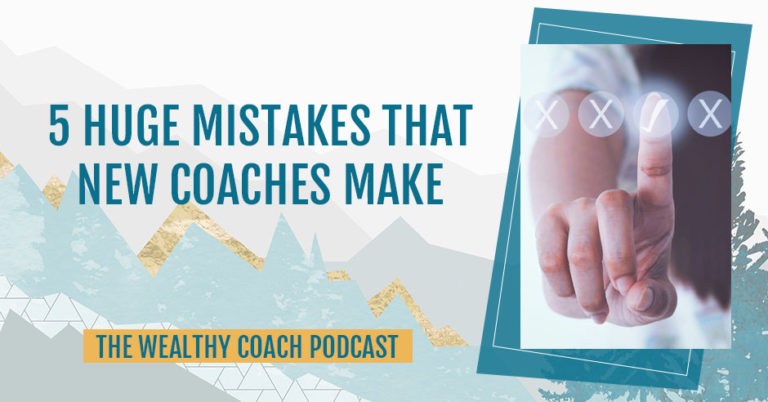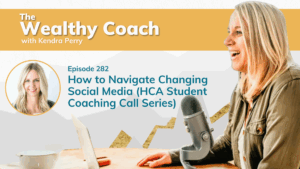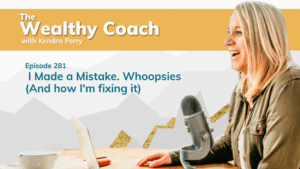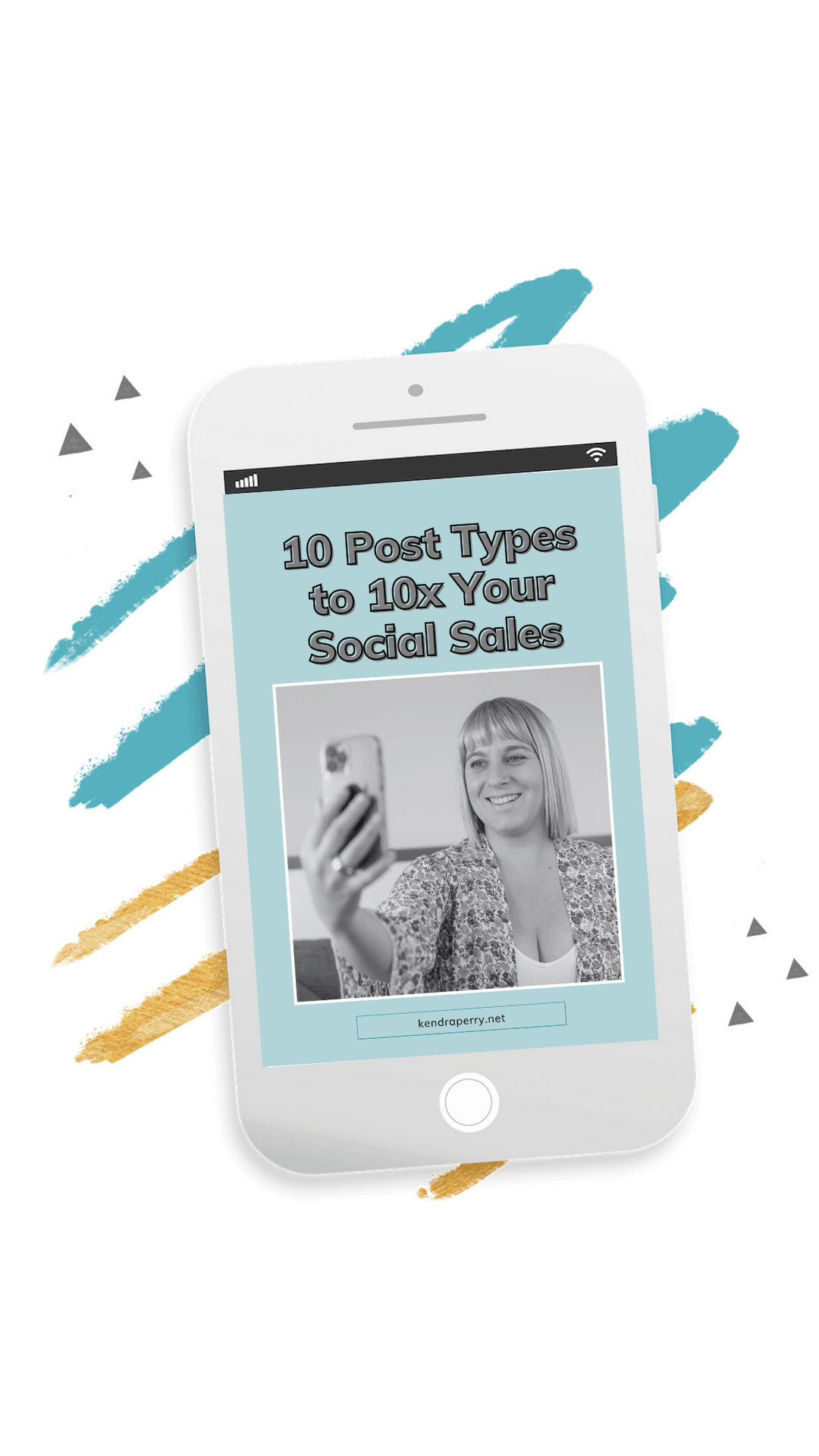What are the mistakes do new coaches make? Host Kendra Perry comes in to lay on the table strategies that will help you avoid five of these. The first common mistake is not being specific enough about your niche. The niche statement guides you to what type of content and program you should be creating. If you try to solve everyone’s problems, you’ll end up not connecting with anybody. Instead, focus on a specific target market, problem, and solution. Doing so allows you to connect with your ideal clients on a much deeper level. Do you want to know what the four remaining mistakes are? Tune in!
Join the Craft Your Signature Offer Challenge: https://bit.ly/signatureofferchallenge
—
Listen to the podcast here:
5 HUGE Mistakes That New Coaches Make
Let’s dive into this episode, which are the five deadly mistakes that most new coaches are making. When I say new coach, if you’re 0 to 3 years into your business, there’s a good chance that you are making one of these mistakes. Those first three years truly are the most difficult time in your business because you’re figuring out and learning a lot. You’re navigating a lot. You’re dealing with the mindset stuff. That’s what I consider a new coach.
Mistake #1: Not Being Specific With Your Niche
We’re going to go over five mistakes. Pay attention carefully because if you’re making these, then this could be the reason why your business isn’t working and you’re not getting the clients that you want. The number one mistake is not being specific enough with your niche. I’ve talked about niching a lot on the show and my social media, but sometimes repetition helps. I know there’s a lot of resistance towards niching because you feel like, “If I niche down too much, aren’t I going to be excluding people?” You want to help everyone, but that’s not the way business works, unfortunately. Imagine there was a store out there that tried to sell everything. If they tried to sell everything, nothing would be that great.
Let’s say you wanted a nice espresso machine. You didn’t want something crappy or something that was going to fall apart. You wanted a good one. You were willing to spend a bit of money on it because you wanted it to last. Would you go to this massive store that sells everything? A good example would be Walmart. They don’t sell everything but they essentially sell most types of things. Walmart is the place you go to get cheap stuff, but it’s not the place to go to get the good stuff. If you got an espresso machine from Walmart, it’s probably not going to last you that long. You wouldn’t have very high expectations of it because Walmart doesn’t specialize in espresso machines.
Where would you go to get the espresso machine? You go to a kitchen specialty shop or a store that specializes in espresso and coffee. That’s where you would go to get that. It’s the same thing with your business. If you’re out there saying, “I help everyone with all types of problems,” you can’t truly understand every issue and the experience that comes with every issue. Marketing is about connection and communication.
This is why it’s important to specialize. You get good at one thing and not just understanding one thing, but understanding the experience that goes along with that one thing. For someone who’s struggling to lose weight versus someone who has rheumatoid arthritis, the experience is different. The pain, the desire and the symptoms are different. Even though what you do as a health coach could potentially help both people with diet, lifestyle, supplements and detox, we have to think about this communication piece.
Therefore, if I’m going to communicate with people to connect with them and I’m saying, “I’ll help you with joint pain, weight loss and all these things,” it doesn’t connect because we need to go deep with people. The niche statement is just the beginning. The niche statement is essentially your billboard, but it’s also a guide for you. It guides you to what type of content and program you should be creating.
A good niche statement includes the problem, the person and the outcome. The person you help, the problem you solve and the outcome you offer. An example of a good niche statement would be, “I help women in their 30s ditch fatigue so they can get back to the sports they love.” See how specific that is? It’s very specific. I’m going to read you a few niche statements. These are real-world niche statements and these missed the mark. Hopefully, now that I’ve explained that you’ll understand why.
“Your emotional state is a reflection of your beliefs. I help you break the belief patterns that are holding you back to change your life.” It’s generic. It’s very vague. What are belief patterns? Do regular everyday people with no education and no training in holistic health and wellness know what belief patterns are? Probably not. Remember that niching is communication. Marketing is communication. What that means is we have to use words that they understand.
You would not want to buy that espresso machine if somebody used some technical term for it. You’d be like, “I don’t know what that is. I want an espresso machine and they’re using a technical term.” If they didn’t use the words that you use, you wouldn’t know what it was or why you should care. “I help you.” Who’s you? We have to nail down this person and who they are. I don’t know who “you” is. It’s essentially anyone.
Belief patterns is not a word that regular people use and it’s vague and then, “Holding you back to change your life.” Who says this? We have to think of this person who we’re trying to attract as you’re sitting down and saying this. Could you imagine me meeting up with a girlfriend and being like, “Chrissy, I need to break these belief patterns that are holding me back so I can change my life?” Chrissy would be like, “Did you just drop acid? Girl, what are you talking about? It doesn’t make sense.” Hopefully, you can see that.
“I help professional women in their 40s reverse their autoimmune condition by helping them to heal their chronic stress, anxiety and trauma so they can reclaim their health and life again.” This one’s a little bit closer than the last one because the professional woman in their 40s is a specific person. If I was a woman working in corporate in my 40s, I would instantly know that was for me.

The problem is autoimmune condition is vague. This might be hard for you to wrap your head around. A lot of people don’t know what an autoimmune condition is. For example, I have a friend who was Hashimoto’s. I remember we were talking about it and I’m like, “You know that Hashimoto’s is an autoimmune condition, right?” She was like, “Is it?” She didn’t know.
That seems crazy to us who have training in health and wellness. We understand these conditions and what they are, but regular people who are getting a diagnosis do not. My friend got her diagnosis years ago. She was given Synthroid and she never did any other research on it. She never had any real intention to heal it holistically. She doesn’t know. She didn’t look into it. The other problem is even though autoimmune conditions all have the same underlying cause of the immune system attacking the tissues, the experience for all of them is different. Remember, communication and connection. We have to connect to their experience.
Someone who has rheumatoid arthritis has very different symptoms than someone who has Hashimoto’s. Rheumatoid arthritis is joint pain and hands turning in versus Hashimoto’s which might be fatigue, weight gain or hair loss. We are going after the experience. This is when you have to take your expert hat off and put your feet in their shoes. “Reclaim their health and life again.” The last part of this says, “Heal chronic stress, anxiety and trauma.” It’s too much. Don’t put your method in the niche statement. Your niche statement is not meant to tell people everything that you do.
What you do to help people is deal with their chronic stress, reduce their anxiety, help them manage trauma, but that doesn’t belong in your niche statement. “Reclaim their health and life again” is vague. I’m sitting down with Chrissy again and I’m saying, “Chrissy, I want to reclaim my health in life again.” Chrissy is like, “Kendra, did you take mushrooms? What are you talking about?” These are not words that people would actually use.
Hopefully, those examples help you understand. A niche statement should be quick. You should be able to say it in one breath, and it should be super specific so that there are no follow-up questions. Practicing your niche statement to someone who is in your life like a friend or family member or potentially a kid. Go talk to a ten-year-old and say your niche statement and see what they say because they will tell you. Fun kids are really honest and you want it to be very specific.
You want to be specific because it’s about communication and connection. The vaguer you are, the less you connect. You want to use their language. You want to use their words. You want to say things that they understand because if you’re standing above them and talking academic language at them, their eyes are going to glaze over and they’re not going to care. They don’t know what you’re talking about. Number one is the niche.
Mistake #2: Lack Of Market Research
Number two is the lack of market research. A lot of people get their niche statement and that’s great, but then they stop. The niche statement is the billboard. It’s your first attraction point, but it’s not your only attraction point. There’s got to be a lot more. The other thing is it’s your guide. It guides you for everything that you do in your business. I’ve said this a million times, but connection and communication are important in marketing. It’s not good enough to just determine your niche statement. You have to dig deeper and you have to get to know these people intimately.
If you feel like sometimes I’m in your head and I’m talking directly to you, why is that? Is it just a coincidence? It’s not. It’s because I have spent thousands of hours speaking with new health coaches. Not only did I used to be one and I remember, but I also go out of my way to have conversations with health coaches all day long. I’m always looking. I’m in a whole bunch of new health coach groups and I’m looking at the questions that they’re asking in those groups. I’m looking at what they’re struggling with.
What will serve you is to find your ideal client and set up an interview with them. This is an interview that has no ulterior motive. You’re not trying to sell them. You’re trying to get information from them. You want to ask them about their struggle, their desire and their experience. You want them to talk a lot so you can take note of the words they’re using. What we’re trying to dive into with communication is you want people to feel like, “They’re in my brain.” You have to understand the tiny struggles, not just the bigger struggle.
I’ve used this example before but it’s a good example, so I’m going to use it again. I have a student inside Group Program Academy who helps women in their 30s heal their acne. I was going through a sales page of hers and I could tell that it wasn’t quite connecting. I was like, “If you want to twist the knife and you want to speak to the struggle, you need to speak about things that only they would understand because they have acne.” I was able to give an example of this because I used to have acne.
When I had acne, when I want to go out to a party, I would navigate around the room based on the lighting. It was always my goal to stand in the darkest part of the room. I never wanted to be in the kitchen or anywhere where there was bright light because I felt vulnerable. I felt like people could see the acne on my face. I always felt more comfortable being in the dark corners of the room until I drank enough and stopped caring.

This is a weird thing. If you’ve never had acne, you might be hearing this for the first time and you might be thinking, “That’s weird, Kendra.” It is weird, but if you’ve had acne, you know exactly what I’m talking about. When I brought this up with my student, she’s like, “I used to do that too.” The point is you want to nail down experiences they are having on the day-to-day that no one else would get, except for someone with that problem. That is how you feel when you’re in your head.
That’s why I can speak to your experiences and you feel like I’m in your head. It’s because I’ve taken a lot of time and effort to get to know you and people like you. It’s not just about the niche statement. It’s about deeply understanding this person. That means interviewing them, being a fly on the wall in Facebook groups, and going through the comments on another coach’s page to see what people are saying, asking and commenting. Take note of the words that they use. Take note of the struggle that they have. Spend some time brainstorming down all the different things that they could be struggling with on a day-to-day basis and the personal things.
This is why it’s so helpful to niche in a problem that you’ve struggled with. Another reason why I can get in your head is because I’ve been the new health coach. Even though it was many years ago, I remember it. It was hard. A lot of the struggles I had then are struggles that you’re having now, so I can speak to that. Communication and connection, remember that. That’s number two. That’s market research or a lack of it.
Mistake #3: Trading Time For Money
Number three mistake is trading time for money. When I say trading time for money, I mean, “You give me $100, I give you an hour of my time.” It’s charging hourly. In my nutrition diploma program, this was essentially the business advice that I got. It was like, “Charge hourly.” That was the experience I had working with holistic practitioners like massage therapists, Chinese medicine doctors, chiropractors and naturopathic doctors. How they charge is per hour.
Most consultants out there are doing that. This is not a business model that I recommend following. I don’t think many people are successful at it unless they get extended health benefits. If you’re licensed, then you are beholden to a licensing board. As a lot of my friends are learning in the COVID times, that might subject them to a mandate that they don’t want to be part of. That’s not the only thing but licensing boards also determine what you can charge, how you can work with people, and even how you can specialize or niche or show up on social media.
One of the reasons why I never got licensed as a health coach was because I didn’t want someone telling me what to do. I’ve been an employee and that didn’t work for me. I used to get fired all the time. I wanted to be on my own. When you don’t have extended health covering your services, people are paying out of pocket. It’s a lot harder to build a practice. I’ve noticed that my massage therapist friends usually can have a full practice within a year and be doing quite well.
It’s different with health coaching because people are always going to seek out what they can get for free or what they can get covered by benefits. It’s a lot harder as a health coach. By trading time for money, you end up in this constant struggle of client acquisition. Even if you can do this business model because maybe extended health does cover what you do or just because you’ve been able to do it, it doesn’t mean it’s a good business model. It’s difficult.
There’s a big difference between massaging someone and helping people with health and nutrition because what you talk about with these people is a lot. It’s hard to juggle hundreds of clients. If you want to make $10,000 per month, you got to get 100 clients and appointments every month. That’s a lot. That’s over two weeks straight of appointments. When are you going to market? When are you going to write your emails? When are you going to do sales calls? When are you going to get your name out there and do marketing and sales? When are you going to do your admin stuff? It’s a crazy business model.
I’ve noticed this with a lot of licensed practitioners that I know. Maybe you are a licensed practitioner and this is the situation you’re in. Maybe you are trading time for money and you’re like, “This is exhausting. I see a new person 5, 6, 7 times a day. I have to juggle. I have to look over the notes. I can’t juggle these people.” Maybe what you want is to provide a deeper level of service. Imagine if you were only taking on five new clients a month? Think how deep you could go with them. Think how well you could know them and connect with them. Think of the intimacy that would create in a coaching container. It’s amazing and different.
A lot of people are seeking that. A lot of people want intimacy. The other problem with trading time for money is the commitment because when someone buys a $100 session, you get zero commitment from them. They’re going to show up for that one session and you may never see them again. That can be incredibly dissatisfying and unfulfilling. That’s generally how I felt at the beginning of my business. I was unsatisfied because people were giving me $100 an hour. They would come in and I would give them recommendations and I would often never see them again. I would encourage them to follow up. Sometimes they didn’t or sometimes they came back months later and they’ve fallen off the wagon. We were starting at square one.
Truly what I wanted when I was a new health coach was to get people results. I know that’s what you want too. I know you have a deep commitment to helping people. You can’t help someone in an hour. When you sell a signature program, you get upfront commitments because a signature program is typically going to be eight weeks, three months or maybe more depending on how you set it up. People are paying for that program upfront and they’re committing to working with you for a period of time. That’s powerful because there is a lot of transformation in a transaction.

When people give away something of value, something that hurts just a little bit, they are going to be way more committed. When was the last time that you were deeply committed to something you got for free? Usually, the more you pay for something, the more committed you’re going to be to the process. What you’ll notice over time is that your highest-paying clients are your lowest maintenance clients. They will do the work. They might ask a couple of questions to clarify, but they’re not going to be emailing you ten times a day and being super high maintenance. That’s what happens when you charge a lower price point.
This is where the signature program comes in. A signature program is a collection of appointments, sessions, support, accountability and resources. It moves someone towards the result that they want. If you want to learn how to build your own signature program and you don’t know where to start, I’m hosting a free five-day challenge starting on February 14th, 2022. If you want to join me for that, you can go to https://Bit.ly/signatureofferchallenge.
Over the five days, we’re going to go through how to choose a topic that sells for your program. I’m going to show you how to structure it. What to put in it and what to make it up with. I’m going to teach you how to name it and brand it so that people are attracted to it. We’re also going to talk about pricing. It’s going to be a lot of fun and I’m giving away a super juicy grand prize so participants can get an entry to win a free scholarship into Health Coach Accelerator, $300 cash and a one-hour coaching session with me, which is pretty valuable because I don’t offer that at all anymore.
Mistake #4: Posting And Ghosting On Social Media
Number four is posting and ghosting on social media and expecting it to get them clients. What is posting and ghosting? Posting and ghosting generally mean creating content for social media, posting it and then sitting in prayer and hoping that you’re going to get a client. It’s not going to work. I call this a passive client acquisition strategy. Passive means you’re not doing anything for it other than creating the content. It is important to be consistent with social media.
Consistency is key and consistency doesn’t mean frequency. When I say consistency, I’m not saying you’re posting five times a day. I’m saying that you’ve come up with a realistic posting schedule and you stick with it no matter what, especially in the early stages of your business. It’s important because you need to keep top of mind with your people. People are always going to check you out on social, regardless of how they find you. If you haven’t posted in a month or two or if you have a crappy social media account, they’re going to think your business isn’t open anymore or they’re going to think you’re not serious or they might be turned off.
It is important to do this but if this is all you’re doing to get clients, it is going to take you so long to grow. Social media is pretty competitive these days. There are a lot of people on it. Your organic reach is generally muted by not only all the people you are competing with but by the social media algorithms in general. It is not a good strategy for fast growth for the majority of people. Some people do it pretty well but most people don’t. It’s definitely an outlier who will grow quickly on social media.
We have to talk more about what I call active client acquisitions tasks. If you’re posting and hoping that someone’s going to find you, it’s going to take you a long time to grow. You need to get out there and find clients. If we’re talking about social media, this is where we get into direct outreach. A lot of people feel gross when I talk about direct outreach. I’m not telling you to be like those annoying multi-level marketers and people who just spam you and are like, “Buy my crap.” I’m not telling you to do that. Do not do that.
What I’m telling you is if you want to get clients, you have to go out and find them. Find your clients on social media and a simple way to do this is to find an expert or a coach who has a large account. Start going through comments of their posts and find people that you can tell are probably your ideal client based on what they commented. If you’re a Hashimoto’s coach, you could go follow Izabella Wentz. Go through her comments and find the comments that give you the information that this person is someone who’s struggling with the condition that you help with.
They may have a private account, in which case this isn’t going to work. If they have a public account, go in and start engaging with them. This can be as simple as liking and commenting on their stuff. You can screenshot something from their feed that you have in common. Maybe they have the same dog as you. Maybe they’ve gone to a place that you want to visit. Maybe they live in a place that you used to live. You can screenshot one of their posts and say, “Where did you get this jacket? How do you like this dog? I’m thinking of getting one. Do you have any recommendations for good places to eat in this place that you visited because I’m heading there soon?”
Whatever it is, you can always find something in common. The goal is to start a conversation with them. Sometimes they’re not going to want to engage with you and that’s okay. It’s important that if they answer you back and you start chatting with them, you do want to make it clear upfront that you’re a coach. If you pretend to be a regular human being and then you suddenly pitch something to them, it can feel dishonest. Once you start the conversation and you introduce yourself, you can be like, “I want to introduce myself. I am Jane. I am a Hashimoto’s coach. I wanted to pop into your DMs and see how you’re doing.”
Some people will want to talk with you. Some people won’t. There might be some awkward silences. What will help is to always finish with a question. Don’t just leave a statement. Always finish with a question and it can be as simple as, “Does that make sense? Does that sound good?” When someone engages with you in a direct message, it is so they’re more likely to see your stuff in their feed, which gives you an opportunity to engage them further with your posts.

Direct outreach and social media engagement are really important. A lot of people are resistant to it but if you do it, it will work. I’m not saying it’s going to work instantly. It’s not a quick fix for your business but it’s a long-term sales strategy. If you want to get high-ticket clients, this is a powerful way to get them. The other thing you can do in terms of active client acquisition is to be your own PR agent. I’ve talked about collaborations, getting booked on podcasts, summits and doing social media collaborations. If you’re just posting to your own tiny audience, it’s going to take you a long time to grow versus doing a podcast interview with someone who has an audience that you wouldn’t otherwise have access to. That’s going to make you grow a lot faster.
Mistake #5: Not Focusing On List Growth
My final mistake is not focusing on list growth. When I say list growth, I mean email list growth. Probably the only regret that I have for my business early on is that I did not focus heavily enough on list growth. Your email list is so critical to the success of your business because you don’t own social media. Those algorithms are always changing. For example, I know a woman who has built her business on Facebook ads and she has an agency. You may or may not be aware but in early 2021, there were some iOS updates that changed how Facebook ads are currently working. Facebook ads have become very complicated and very difficult. If your business is based on someone else’s business, then when that business shifts, then that can impact your business. She went through a very hard time with her business.
If you’re using Instagram and Instagram changes its algorithm overnight and suddenly you can’t access your followers anymore, you don’t have access to your audience. That’s a big deal. The email list simply provides insurance and it gives you a way to communicate and stay in touch with your people. What I will tell you is every one of my launches, almost everyone is buying from my email list. I do get a few direct sales from Instagram. The people who weren’t on my list, who will hop into the program. They were likely following me on Instagram for quite some time but most people buy through email. Email marketing is powerful.
I’ve heard a statistic that for every $1 that you put into email marketing, you get $40 back. List growth can be quite inexpensive, so it’s important to create a freebie and it should be specifically for your ideal client. It should solve a pain point and give them a quick win. This will help you build your email list. Focus on your email list. You don’t only want to get people on your list, but you want to nurture them once they’re on there. Send them a weekly email and don’t set this up like newsletter style. You don’t want to have multiple things in there.
Each email should have one point. You could give them a tip or you could tell a story. Stories are amazing for email nurturing. Be more aware in your everyday life and notice the lessons that you learn. Ask yourself, “Is this a lesson that my audience could benefit from?” Stories are powerful. If you do a mixture of stories and educational stuff, then that will be great. That will nurture them and help them go from “I just met you” to “Now, maybe I want to work with you.” Do focus on list growth. If you haven’t done anything to start your email list, now is the time to start.
Let’s do a quick summary of these five mistakes that new coaches tend to make. Number one is not being specific enough with their niche. You’ve got to niche down and your niche needs to be specific. Number two is the lack of market research. It is your mission to get to know your ideal client better than they know themselves. Number three is trading time for money. Please create a signature program and remember to join my five-day free craft your signature offer challenge by going to https://Bit.ly/signatureofferchallenge.
Number four is posting and ghosting on social media and hoping that’s going to help you grow. I would rather you post less on social media and spend more time with direct outreach. Number five is not focusing on list growth. If you don’t have an email list, now is the perfect time to start. Build your freebie and get that email list up and running.
I hope you found this episode valuable. If you love this episode, I would more than appreciate it if you could give me a five-star review on Apple Podcasts. You can simply do that on the app. If you are on Android, you have to go into iTunes on your desktop and you can leave me a review there. These reviews help me get my message out to other health coaches. It’s a very simple and free way to support me if you are getting a lot from these episodes. I will see you again soon.
Important Links:
- https://Bit.ly/signatureofferchallenge
- Group Program Academy
- Health Coach Accelerator
- Apple Podcasts – The Wealthy Coach






